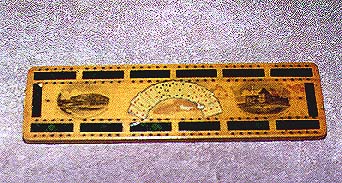♠ Article Library ♦ Board Gallery
Everybody has had advertising memorabilia in their possession at one time or another - key chains, calendars, pens, ash trays - the list is endless. In fact, by today's standards, even old cans, boxes and bottles with labels on them are considered collectible and can fetch a hefty price on the open market! Long overdue is a feature about advertising cribbage boards, for there are far more being preserved in collections than your wildest dreams can imagine!
The history of the distribution of advertising giveaways goes back to the mid-1800's (perhaps earlier), prior to the era of widespread access to newspapers, catalogs such as Sears, or modern transportation. In order to reach the interest of potential customers who were scattered far and wide, some enterprising manufacturer came up with the idea to give away small products with the company name imprinted on them. Who the earliest entrepreneur was and where he was located isn't known, but the idea flew, and the world was soon flooded with advertising products. For many years, advertising products were given away, but with the advent of new advertising techniques, venders and manufacturers were able to reach far more people, and the distribution of advertising giveaways took on a lesser role. Advertising products are still available, but the distribution techniques have changed and more frequently the products now have to be purchased.
Three countries are known to have produced advertising cribbage boards in any great quantity, and they were England, Scotland and Canada.

Mt. Kineo Moosehead Lake, Maine
Although Scottish Souvenir Ware is usually associated with souvenir memorabilia, its eye-catching quality served the dual purpose of tempting potential travelers to the sites shown on the product. Mauchline ware originated in the early 1800's (where else but in Mauchline Ayrshire, Scotland), but the main manufacture of the products was soon moved to the nearby town of Cumnock in Ayrshire. A wide range of products was produced for both provincial and export use from the mid- 1800's until approximately 1930. Amazingly enough, the pictorial transfers were so well sealed by multiple coats of varnish, a process that took up to 12 weeks to complete, that many fine examples of Mauchline ware are still being found and added to collections.

Wills's Star Cigarettes
The early use of advertising cribbage boards appears to have originated in England. There are fine examples of English boards in American collections, many of which advertise tobacco products and brews. With the influx of English immigrants to the United States in the late 1800's, it is presumed that many of them brought their cribbage boards with them. Because most immigrants brought little more than what they could carry , the boards, which took up little space in their valises, were brought along in order to provide a familiar and comfortable activity in their free time. When my grandparents and father immigrated to this country in 1909, they brought their board with them for that very purpose!
The English Wills's tobacco products dominate the list of advertising boards in the archives of the CBCS. Wills's Gold Flake, Wills's Woodbines, Wills's Star Cigarettes are some of the boards that are held and prized by collectors. Many are wooden, but a few plastic ones are listed, indicating that the manufacture and distribution has continued through to recent years.

Weights Players Cigarettes
Other English advertising boards include:
Jacques London (a former manufacturer of games)
Compliments of Simonds
Acme Ruler and Advertising Co., Ltd. of Toronto was the most prominent manufacturer of advertising boards in Canada. The full extent of the boards manufactured by them for various firms isn't yet known, for new boards continue to surface that have the classic features of Acme cribbage boards. Although few boards are identified with the "Acme" name, the streamlined end (see Photo 4) is one of their classic features. Many of their boards also have the Brooks-style tracks (see Photo 4), a patented design which was made popular by them in the 1950's. Other Acme advertising boards with one or both of these features include the following:
Air CanadaAcme also manufactured other styles of advertising boards, including the round Twinlane board for H.A. Sicotte Mfg. Co., which is pictured in Article No. 5 (Lost and Found).
By today's standards, Acme has been the most prolific modern day foreign manufacturer of advertising boards, and the height of their activity appears to have been from the 1950's to early 1970's. Thus far, attempts to track the company's history after that period comes to a screeching halt, and I would really appreciate any additional information on Acme Ruler and Advertising Co., Ltd. that readers can contribute to my files.
This concludes the segment on foreign advertising boards. My next article will feature American manufacturers of advertising boards, a review that will take us back to the late 1800's. Once again, I want to express my thanks to Super Collector Tom O'Gara, who has provided me with much information on this subject.